Business Strategy Report: An In-Depth Analysis of IKEA's Operations
VerifiedAdded on 2023/01/11
|16
|5066
|99
Report
AI Summary
This report offers a comprehensive analysis of IKEA's business strategy, examining its mission, vision, and objectives. It delves into the influence of the external environment using PESTLE and stakeholder analyses, evaluating political, economic, social, technological, legal, and environmental factors. The report assesses IKEA's internal environment through SWOT and VRIO frameworks, identifying strengths, weaknesses, opportunities, and threats, and evaluating the value, rareness, imitability, and organization of its resources. Furthermore, it evaluates IKEA's competitive positioning and proposes strategic management plans to enhance its market share and customer base. The report concludes with strategic recommendations for IKEA's future growth and success.
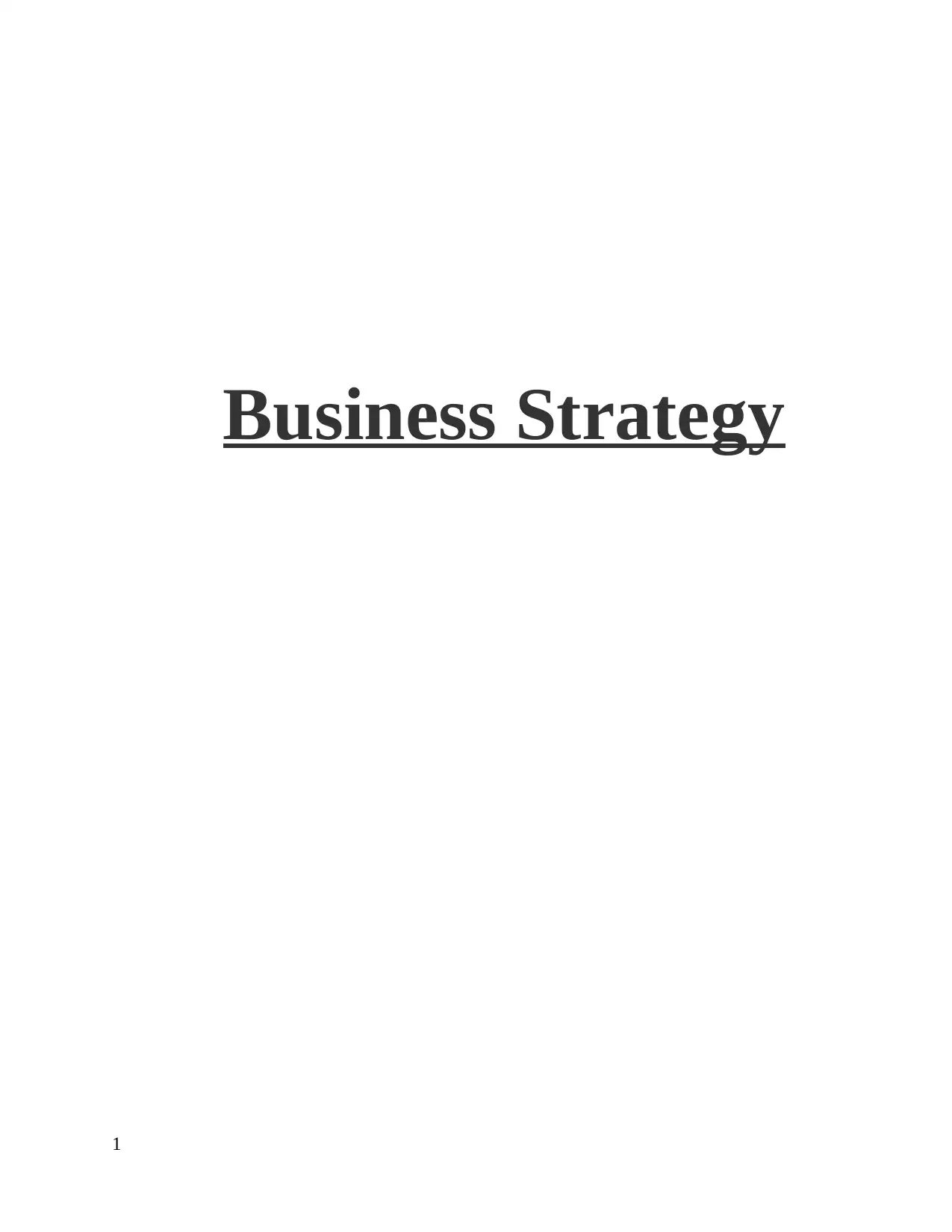
Business Strategy
1
1
Paraphrase This Document
Need a fresh take? Get an instant paraphrase of this document with our AI Paraphraser
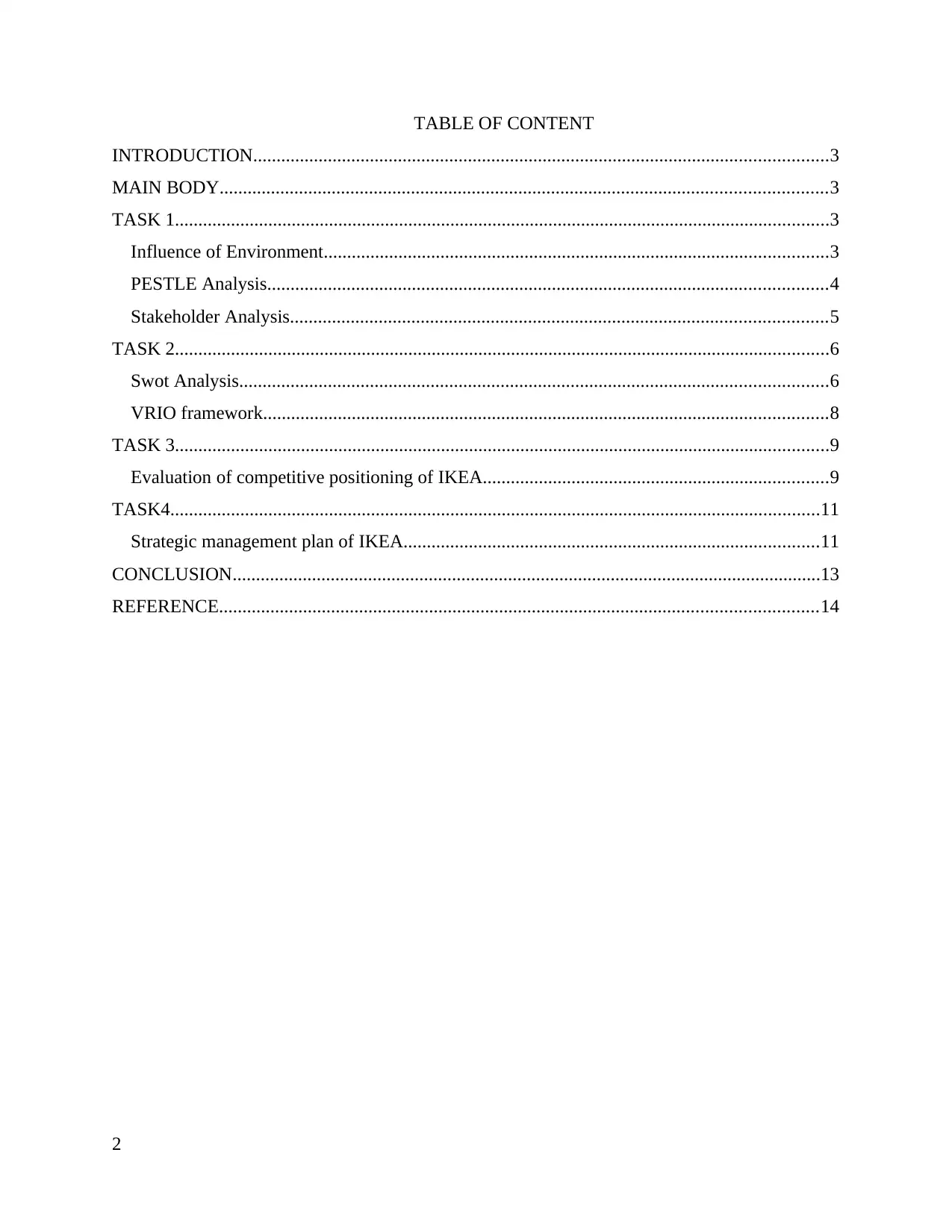
TABLE OF CONTENT
INTRODUCTION...........................................................................................................................3
MAIN BODY..................................................................................................................................3
TASK 1............................................................................................................................................3
Influence of Environment............................................................................................................3
PESTLE Analysis........................................................................................................................4
Stakeholder Analysis...................................................................................................................5
TASK 2............................................................................................................................................6
Swot Analysis..............................................................................................................................6
VRIO framework.........................................................................................................................8
TASK 3............................................................................................................................................9
Evaluation of competitive positioning of IKEA..........................................................................9
TASK4...........................................................................................................................................11
Strategic management plan of IKEA.........................................................................................11
CONCLUSION..............................................................................................................................13
REFERENCE................................................................................................................................14
2
INTRODUCTION...........................................................................................................................3
MAIN BODY..................................................................................................................................3
TASK 1............................................................................................................................................3
Influence of Environment............................................................................................................3
PESTLE Analysis........................................................................................................................4
Stakeholder Analysis...................................................................................................................5
TASK 2............................................................................................................................................6
Swot Analysis..............................................................................................................................6
VRIO framework.........................................................................................................................8
TASK 3............................................................................................................................................9
Evaluation of competitive positioning of IKEA..........................................................................9
TASK4...........................................................................................................................................11
Strategic management plan of IKEA.........................................................................................11
CONCLUSION..............................................................................................................................13
REFERENCE................................................................................................................................14
2
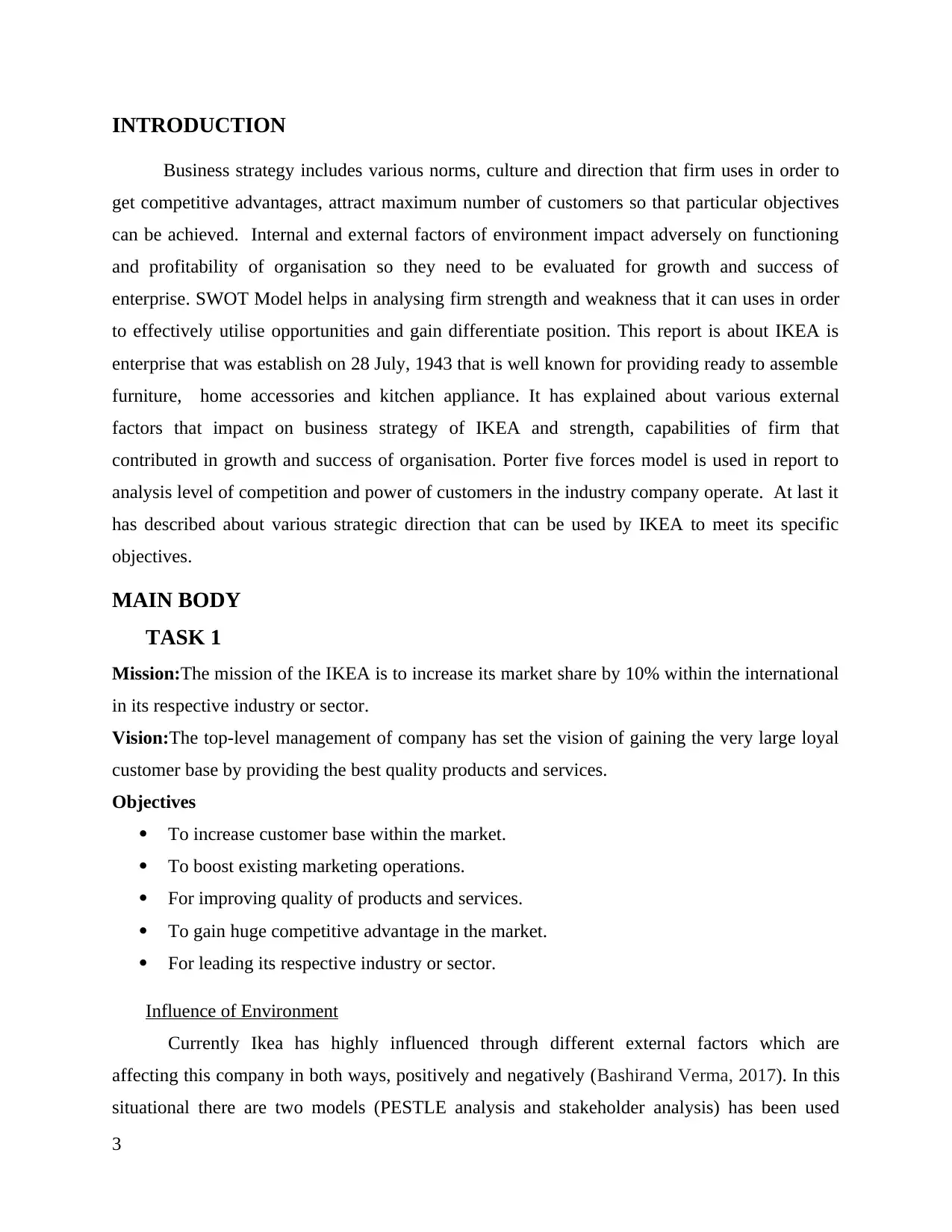
INTRODUCTION
Business strategy includes various norms, culture and direction that firm uses in order to
get competitive advantages, attract maximum number of customers so that particular objectives
can be achieved. Internal and external factors of environment impact adversely on functioning
and profitability of organisation so they need to be evaluated for growth and success of
enterprise. SWOT Model helps in analysing firm strength and weakness that it can uses in order
to effectively utilise opportunities and gain differentiate position. This report is about IKEA is
enterprise that was establish on 28 July, 1943 that is well known for providing ready to assemble
furniture, home accessories and kitchen appliance. It has explained about various external
factors that impact on business strategy of IKEA and strength, capabilities of firm that
contributed in growth and success of organisation. Porter five forces model is used in report to
analysis level of competition and power of customers in the industry company operate. At last it
has described about various strategic direction that can be used by IKEA to meet its specific
objectives.
MAIN BODY
TASK 1
Mission:The mission of the IKEA is to increase its market share by 10% within the international
in its respective industry or sector.
Vision:The top-level management of company has set the vision of gaining the very large loyal
customer base by providing the best quality products and services.
Objectives
To increase customer base within the market.
To boost existing marketing operations.
For improving quality of products and services.
To gain huge competitive advantage in the market.
For leading its respective industry or sector.
Influence of Environment
Currently Ikea has highly influenced through different external factors which are
affecting this company in both ways, positively and negatively (Bashirand Verma, 2017). In this
situational there are two models (PESTLE analysis and stakeholder analysis) has been used
3
Business strategy includes various norms, culture and direction that firm uses in order to
get competitive advantages, attract maximum number of customers so that particular objectives
can be achieved. Internal and external factors of environment impact adversely on functioning
and profitability of organisation so they need to be evaluated for growth and success of
enterprise. SWOT Model helps in analysing firm strength and weakness that it can uses in order
to effectively utilise opportunities and gain differentiate position. This report is about IKEA is
enterprise that was establish on 28 July, 1943 that is well known for providing ready to assemble
furniture, home accessories and kitchen appliance. It has explained about various external
factors that impact on business strategy of IKEA and strength, capabilities of firm that
contributed in growth and success of organisation. Porter five forces model is used in report to
analysis level of competition and power of customers in the industry company operate. At last it
has described about various strategic direction that can be used by IKEA to meet its specific
objectives.
MAIN BODY
TASK 1
Mission:The mission of the IKEA is to increase its market share by 10% within the international
in its respective industry or sector.
Vision:The top-level management of company has set the vision of gaining the very large loyal
customer base by providing the best quality products and services.
Objectives
To increase customer base within the market.
To boost existing marketing operations.
For improving quality of products and services.
To gain huge competitive advantage in the market.
For leading its respective industry or sector.
Influence of Environment
Currently Ikea has highly influenced through different external factors which are
affecting this company in both ways, positively and negatively (Bashirand Verma, 2017). In this
situational there are two models (PESTLE analysis and stakeholder analysis) has been used
3
⊘ This is a preview!⊘
Do you want full access?
Subscribe today to unlock all pages.

Trusted by 1+ million students worldwide
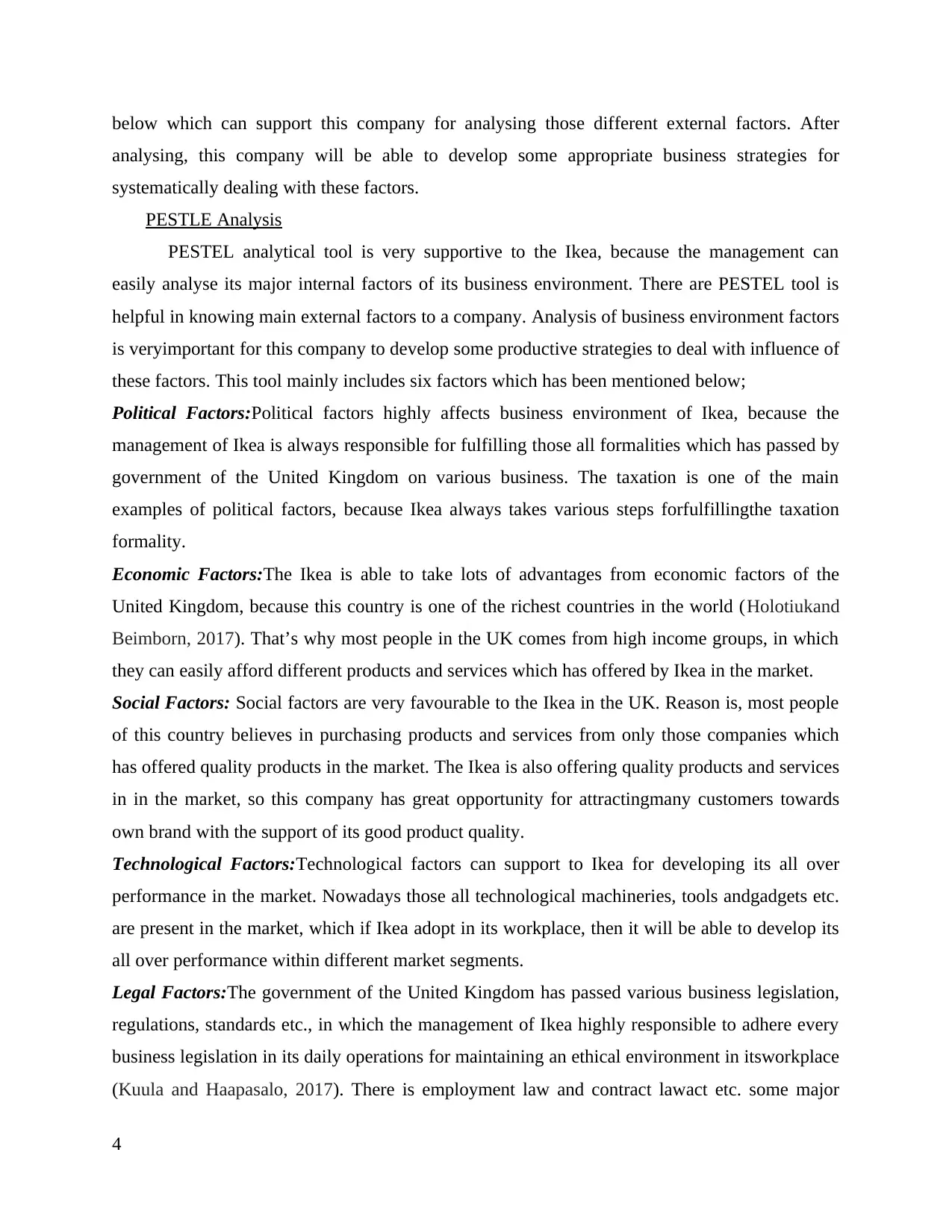
below which can support this company for analysing those different external factors. After
analysing, this company will be able to develop some appropriate business strategies for
systematically dealing with these factors.
PESTLE Analysis
PESTEL analytical tool is very supportive to the Ikea, because the management can
easily analyse its major internal factors of its business environment. There are PESTEL tool is
helpful in knowing main external factors to a company. Analysis of business environment factors
is veryimportant for this company to develop some productive strategies to deal with influence of
these factors. This tool mainly includes six factors which has been mentioned below;
Political Factors:Political factors highly affects business environment of Ikea, because the
management of Ikea is always responsible for fulfilling those all formalities which has passed by
government of the United Kingdom on various business. The taxation is one of the main
examples of political factors, because Ikea always takes various steps forfulfillingthe taxation
formality.
Economic Factors:The Ikea is able to take lots of advantages from economic factors of the
United Kingdom, because this country is one of the richest countries in the world (Holotiukand
Beimborn, 2017). That’s why most people in the UK comes from high income groups, in which
they can easily afford different products and services which has offered by Ikea in the market.
Social Factors: Social factors are very favourable to the Ikea in the UK. Reason is, most people
of this country believes in purchasing products and services from only those companies which
has offered quality products in the market. The Ikea is also offering quality products and services
in in the market, so this company has great opportunity for attractingmany customers towards
own brand with the support of its good product quality.
Technological Factors:Technological factors can support to Ikea for developing its all over
performance in the market. Nowadays those all technological machineries, tools andgadgets etc.
are present in the market, which if Ikea adopt in its workplace, then it will be able to develop its
all over performance within different market segments.
Legal Factors:The government of the United Kingdom has passed various business legislation,
regulations, standards etc., in which the management of Ikea highly responsible to adhere every
business legislation in its daily operations for maintaining an ethical environment in itsworkplace
(Kuula and Haapasalo, 2017). There is employment law and contract lawact etc. some major
4
analysing, this company will be able to develop some appropriate business strategies for
systematically dealing with these factors.
PESTLE Analysis
PESTEL analytical tool is very supportive to the Ikea, because the management can
easily analyse its major internal factors of its business environment. There are PESTEL tool is
helpful in knowing main external factors to a company. Analysis of business environment factors
is veryimportant for this company to develop some productive strategies to deal with influence of
these factors. This tool mainly includes six factors which has been mentioned below;
Political Factors:Political factors highly affects business environment of Ikea, because the
management of Ikea is always responsible for fulfilling those all formalities which has passed by
government of the United Kingdom on various business. The taxation is one of the main
examples of political factors, because Ikea always takes various steps forfulfillingthe taxation
formality.
Economic Factors:The Ikea is able to take lots of advantages from economic factors of the
United Kingdom, because this country is one of the richest countries in the world (Holotiukand
Beimborn, 2017). That’s why most people in the UK comes from high income groups, in which
they can easily afford different products and services which has offered by Ikea in the market.
Social Factors: Social factors are very favourable to the Ikea in the UK. Reason is, most people
of this country believes in purchasing products and services from only those companies which
has offered quality products in the market. The Ikea is also offering quality products and services
in in the market, so this company has great opportunity for attractingmany customers towards
own brand with the support of its good product quality.
Technological Factors:Technological factors can support to Ikea for developing its all over
performance in the market. Nowadays those all technological machineries, tools andgadgets etc.
are present in the market, which if Ikea adopt in its workplace, then it will be able to develop its
all over performance within different market segments.
Legal Factors:The government of the United Kingdom has passed various business legislation,
regulations, standards etc., in which the management of Ikea highly responsible to adhere every
business legislation in its daily operations for maintaining an ethical environment in itsworkplace
(Kuula and Haapasalo, 2017). There is employment law and contract lawact etc. some major
4
Paraphrase This Document
Need a fresh take? Get an instant paraphrase of this document with our AI Paraphraser
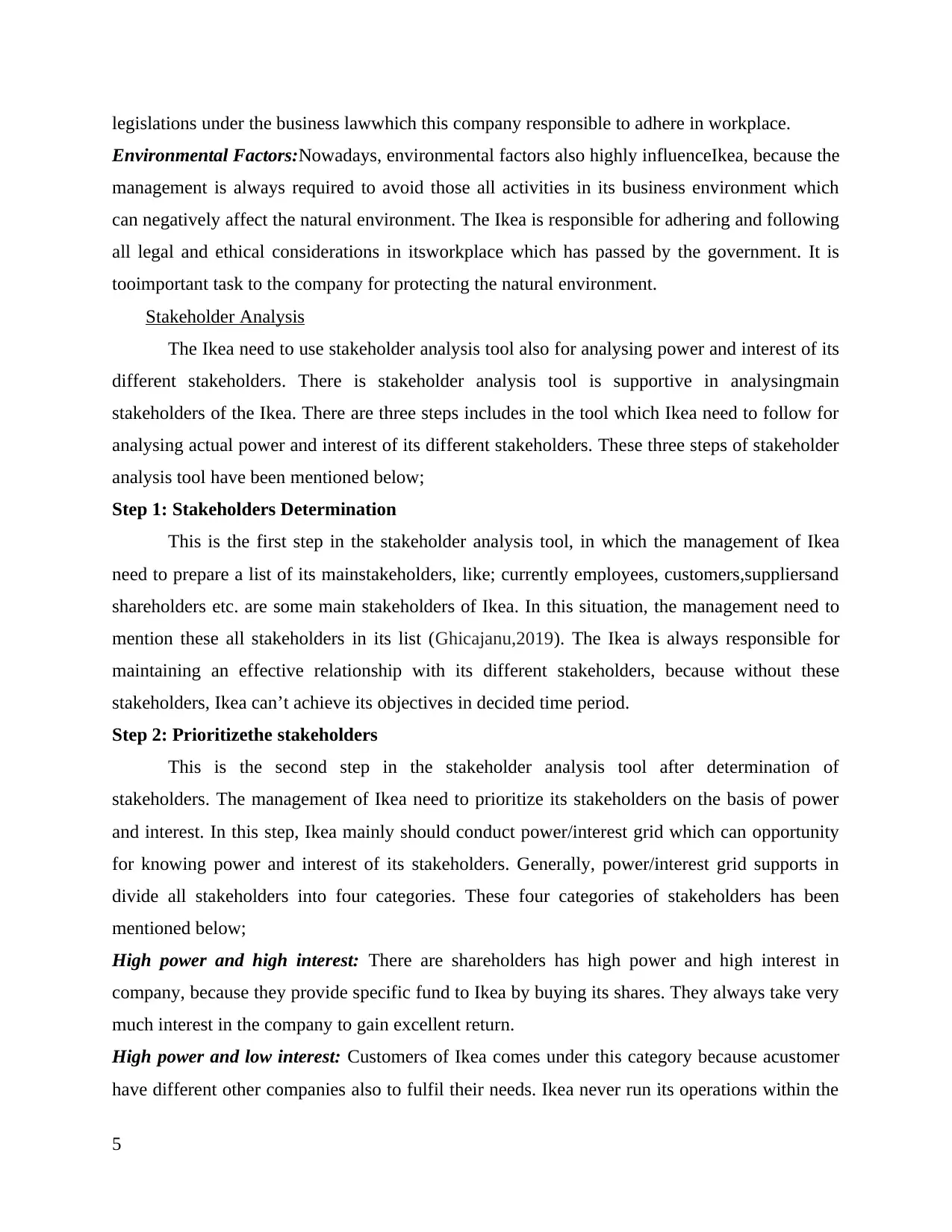
legislations under the business lawwhich this company responsible to adhere in workplace.
Environmental Factors:Nowadays, environmental factors also highly influenceIkea, because the
management is always required to avoid those all activities in its business environment which
can negatively affect the natural environment. The Ikea is responsible for adhering and following
all legal and ethical considerations in itsworkplace which has passed by the government. It is
tooimportant task to the company for protecting the natural environment.
Stakeholder Analysis
The Ikea need to use stakeholder analysis tool also for analysing power and interest of its
different stakeholders. There is stakeholder analysis tool is supportive in analysingmain
stakeholders of the Ikea. There are three steps includes in the tool which Ikea need to follow for
analysing actual power and interest of its different stakeholders. These three steps of stakeholder
analysis tool have been mentioned below;
Step 1: Stakeholders Determination
This is the first step in the stakeholder analysis tool, in which the management of Ikea
need to prepare a list of its mainstakeholders, like; currently employees, customers,suppliersand
shareholders etc. are some main stakeholders of Ikea. In this situation, the management need to
mention these all stakeholders in its list (Ghicajanu,2019). The Ikea is always responsible for
maintaining an effective relationship with its different stakeholders, because without these
stakeholders, Ikea can’t achieve its objectives in decided time period.
Step 2: Prioritizethe stakeholders
This is the second step in the stakeholder analysis tool after determination of
stakeholders. The management of Ikea need to prioritize its stakeholders on the basis of power
and interest. In this step, Ikea mainly should conduct power/interest grid which can opportunity
for knowing power and interest of its stakeholders. Generally, power/interest grid supports in
divide all stakeholders into four categories. These four categories of stakeholders has been
mentioned below;
High power and high interest: There are shareholders has high power and high interest in
company, because they provide specific fund to Ikea by buying its shares. They always take very
much interest in the company to gain excellent return.
High power and low interest: Customers of Ikea comes under this category because acustomer
have different other companies also to fulfil their needs. Ikea never run its operations within the
5
Environmental Factors:Nowadays, environmental factors also highly influenceIkea, because the
management is always required to avoid those all activities in its business environment which
can negatively affect the natural environment. The Ikea is responsible for adhering and following
all legal and ethical considerations in itsworkplace which has passed by the government. It is
tooimportant task to the company for protecting the natural environment.
Stakeholder Analysis
The Ikea need to use stakeholder analysis tool also for analysing power and interest of its
different stakeholders. There is stakeholder analysis tool is supportive in analysingmain
stakeholders of the Ikea. There are three steps includes in the tool which Ikea need to follow for
analysing actual power and interest of its different stakeholders. These three steps of stakeholder
analysis tool have been mentioned below;
Step 1: Stakeholders Determination
This is the first step in the stakeholder analysis tool, in which the management of Ikea
need to prepare a list of its mainstakeholders, like; currently employees, customers,suppliersand
shareholders etc. are some main stakeholders of Ikea. In this situation, the management need to
mention these all stakeholders in its list (Ghicajanu,2019). The Ikea is always responsible for
maintaining an effective relationship with its different stakeholders, because without these
stakeholders, Ikea can’t achieve its objectives in decided time period.
Step 2: Prioritizethe stakeholders
This is the second step in the stakeholder analysis tool after determination of
stakeholders. The management of Ikea need to prioritize its stakeholders on the basis of power
and interest. In this step, Ikea mainly should conduct power/interest grid which can opportunity
for knowing power and interest of its stakeholders. Generally, power/interest grid supports in
divide all stakeholders into four categories. These four categories of stakeholders has been
mentioned below;
High power and high interest: There are shareholders has high power and high interest in
company, because they provide specific fund to Ikea by buying its shares. They always take very
much interest in the company to gain excellent return.
High power and low interest: Customers of Ikea comes under this category because acustomer
have different other companies also to fulfil their needs. Ikea never run its operations within the
5
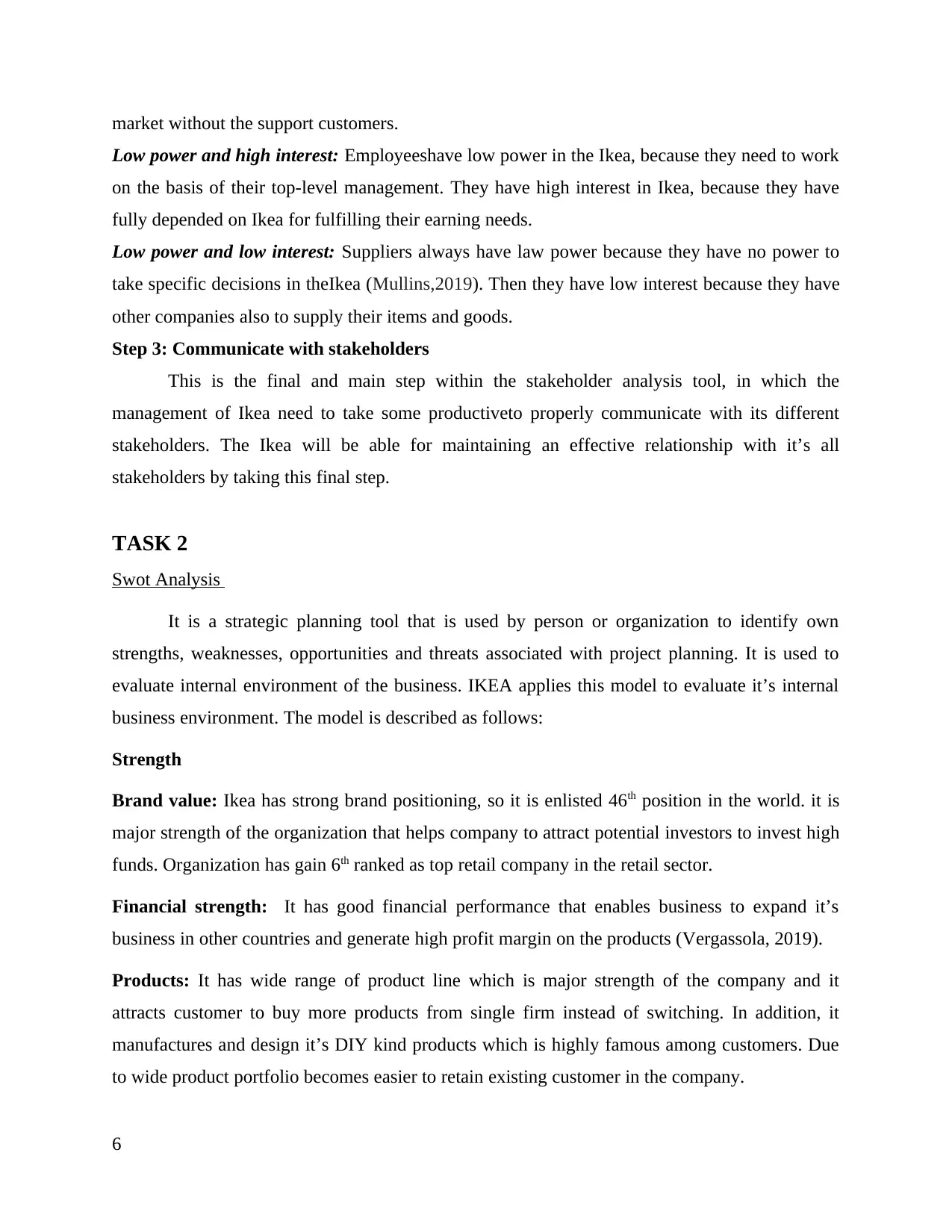
market without the support customers.
Low power and high interest: Employeeshave low power in the Ikea, because they need to work
on the basis of their top-level management. They have high interest in Ikea, because they have
fully depended on Ikea for fulfilling their earning needs.
Low power and low interest: Suppliers always have law power because they have no power to
take specific decisions in theIkea (Mullins,2019). Then they have low interest because they have
other companies also to supply their items and goods.
Step 3: Communicate with stakeholders
This is the final and main step within the stakeholder analysis tool, in which the
management of Ikea need to take some productiveto properly communicate with its different
stakeholders. The Ikea will be able for maintaining an effective relationship with it’s all
stakeholders by taking this final step.
TASK 2
Swot Analysis
It is a strategic planning tool that is used by person or organization to identify own
strengths, weaknesses, opportunities and threats associated with project planning. It is used to
evaluate internal environment of the business. IKEA applies this model to evaluate it’s internal
business environment. The model is described as follows:
Strength
Brand value: Ikea has strong brand positioning, so it is enlisted 46th position in the world. it is
major strength of the organization that helps company to attract potential investors to invest high
funds. Organization has gain 6th ranked as top retail company in the retail sector.
Financial strength: It has good financial performance that enables business to expand it’s
business in other countries and generate high profit margin on the products (Vergassola, 2019).
Products: It has wide range of product line which is major strength of the company and it
attracts customer to buy more products from single firm instead of switching. In addition, it
manufactures and design it’s DIY kind products which is highly famous among customers. Due
to wide product portfolio becomes easier to retain existing customer in the company.
6
Low power and high interest: Employeeshave low power in the Ikea, because they need to work
on the basis of their top-level management. They have high interest in Ikea, because they have
fully depended on Ikea for fulfilling their earning needs.
Low power and low interest: Suppliers always have law power because they have no power to
take specific decisions in theIkea (Mullins,2019). Then they have low interest because they have
other companies also to supply their items and goods.
Step 3: Communicate with stakeholders
This is the final and main step within the stakeholder analysis tool, in which the
management of Ikea need to take some productiveto properly communicate with its different
stakeholders. The Ikea will be able for maintaining an effective relationship with it’s all
stakeholders by taking this final step.
TASK 2
Swot Analysis
It is a strategic planning tool that is used by person or organization to identify own
strengths, weaknesses, opportunities and threats associated with project planning. It is used to
evaluate internal environment of the business. IKEA applies this model to evaluate it’s internal
business environment. The model is described as follows:
Strength
Brand value: Ikea has strong brand positioning, so it is enlisted 46th position in the world. it is
major strength of the organization that helps company to attract potential investors to invest high
funds. Organization has gain 6th ranked as top retail company in the retail sector.
Financial strength: It has good financial performance that enables business to expand it’s
business in other countries and generate high profit margin on the products (Vergassola, 2019).
Products: It has wide range of product line which is major strength of the company and it
attracts customer to buy more products from single firm instead of switching. In addition, it
manufactures and design it’s DIY kind products which is highly famous among customers. Due
to wide product portfolio becomes easier to retain existing customer in the company.
6
⊘ This is a preview!⊘
Do you want full access?
Subscribe today to unlock all pages.

Trusted by 1+ million students worldwide
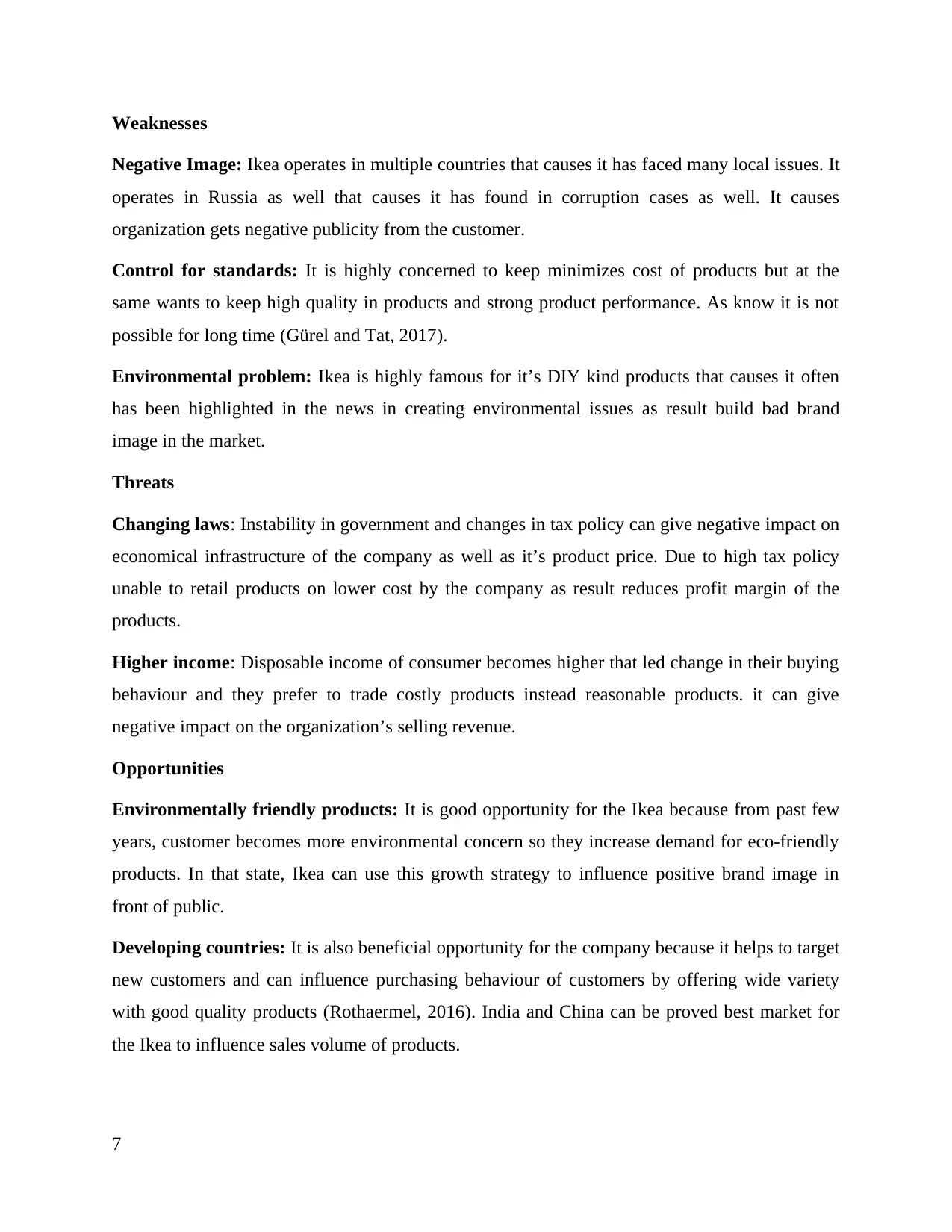
Weaknesses
Negative Image: Ikea operates in multiple countries that causes it has faced many local issues. It
operates in Russia as well that causes it has found in corruption cases as well. It causes
organization gets negative publicity from the customer.
Control for standards: It is highly concerned to keep minimizes cost of products but at the
same wants to keep high quality in products and strong product performance. As know it is not
possible for long time (Gürel and Tat, 2017).
Environmental problem: Ikea is highly famous for it’s DIY kind products that causes it often
has been highlighted in the news in creating environmental issues as result build bad brand
image in the market.
Threats
Changing laws: Instability in government and changes in tax policy can give negative impact on
economical infrastructure of the company as well as it’s product price. Due to high tax policy
unable to retail products on lower cost by the company as result reduces profit margin of the
products.
Higher income: Disposable income of consumer becomes higher that led change in their buying
behaviour and they prefer to trade costly products instead reasonable products. it can give
negative impact on the organization’s selling revenue.
Opportunities
Environmentally friendly products: It is good opportunity for the Ikea because from past few
years, customer becomes more environmental concern so they increase demand for eco-friendly
products. In that state, Ikea can use this growth strategy to influence positive brand image in
front of public.
Developing countries: It is also beneficial opportunity for the company because it helps to target
new customers and can influence purchasing behaviour of customers by offering wide variety
with good quality products (Rothaermel, 2016). India and China can be proved best market for
the Ikea to influence sales volume of products.
7
Negative Image: Ikea operates in multiple countries that causes it has faced many local issues. It
operates in Russia as well that causes it has found in corruption cases as well. It causes
organization gets negative publicity from the customer.
Control for standards: It is highly concerned to keep minimizes cost of products but at the
same wants to keep high quality in products and strong product performance. As know it is not
possible for long time (Gürel and Tat, 2017).
Environmental problem: Ikea is highly famous for it’s DIY kind products that causes it often
has been highlighted in the news in creating environmental issues as result build bad brand
image in the market.
Threats
Changing laws: Instability in government and changes in tax policy can give negative impact on
economical infrastructure of the company as well as it’s product price. Due to high tax policy
unable to retail products on lower cost by the company as result reduces profit margin of the
products.
Higher income: Disposable income of consumer becomes higher that led change in their buying
behaviour and they prefer to trade costly products instead reasonable products. it can give
negative impact on the organization’s selling revenue.
Opportunities
Environmentally friendly products: It is good opportunity for the Ikea because from past few
years, customer becomes more environmental concern so they increase demand for eco-friendly
products. In that state, Ikea can use this growth strategy to influence positive brand image in
front of public.
Developing countries: It is also beneficial opportunity for the company because it helps to target
new customers and can influence purchasing behaviour of customers by offering wide variety
with good quality products (Rothaermel, 2016). India and China can be proved best market for
the Ikea to influence sales volume of products.
7
Paraphrase This Document
Need a fresh take? Get an instant paraphrase of this document with our AI Paraphraser
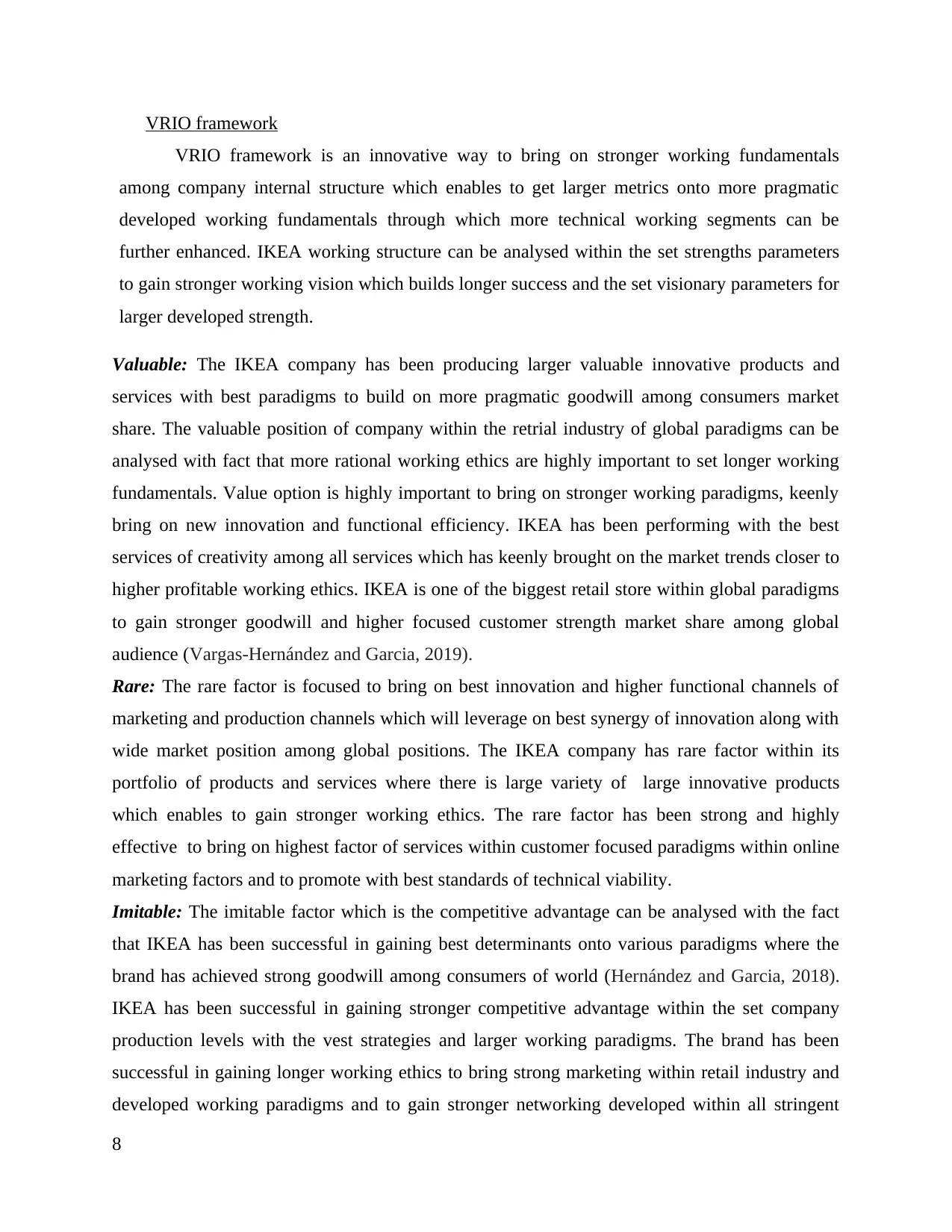
VRIO framework
VRIO framework is an innovative way to bring on stronger working fundamentals
among company internal structure which enables to get larger metrics onto more pragmatic
developed working fundamentals through which more technical working segments can be
further enhanced. IKEA working structure can be analysed within the set strengths parameters
to gain stronger working vision which builds longer success and the set visionary parameters for
larger developed strength.
Valuable: The IKEA company has been producing larger valuable innovative products and
services with best paradigms to build on more pragmatic goodwill among consumers market
share. The valuable position of company within the retrial industry of global paradigms can be
analysed with fact that more rational working ethics are highly important to set longer working
fundamentals. Value option is highly important to bring on stronger working paradigms, keenly
bring on new innovation and functional efficiency. IKEA has been performing with the best
services of creativity among all services which has keenly brought on the market trends closer to
higher profitable working ethics. IKEA is one of the biggest retail store within global paradigms
to gain stronger goodwill and higher focused customer strength market share among global
audience (Vargas-Hernández and Garcia, 2019).
Rare: The rare factor is focused to bring on best innovation and higher functional channels of
marketing and production channels which will leverage on best synergy of innovation along with
wide market position among global positions. The IKEA company has rare factor within its
portfolio of products and services where there is large variety of large innovative products
which enables to gain stronger working ethics. The rare factor has been strong and highly
effective to bring on highest factor of services within customer focused paradigms within online
marketing factors and to promote with best standards of technical viability.
Imitable: The imitable factor which is the competitive advantage can be analysed with the fact
that IKEA has been successful in gaining best determinants onto various paradigms where the
brand has achieved strong goodwill among consumers of world (Hernández and Garcia, 2018).
IKEA has been successful in gaining stronger competitive advantage within the set company
production levels with the vest strategies and larger working paradigms. The brand has been
successful in gaining longer working ethics to bring strong marketing within retail industry and
developed working paradigms and to gain stronger networking developed within all stringent
8
VRIO framework is an innovative way to bring on stronger working fundamentals
among company internal structure which enables to get larger metrics onto more pragmatic
developed working fundamentals through which more technical working segments can be
further enhanced. IKEA working structure can be analysed within the set strengths parameters
to gain stronger working vision which builds longer success and the set visionary parameters for
larger developed strength.
Valuable: The IKEA company has been producing larger valuable innovative products and
services with best paradigms to build on more pragmatic goodwill among consumers market
share. The valuable position of company within the retrial industry of global paradigms can be
analysed with fact that more rational working ethics are highly important to set longer working
fundamentals. Value option is highly important to bring on stronger working paradigms, keenly
bring on new innovation and functional efficiency. IKEA has been performing with the best
services of creativity among all services which has keenly brought on the market trends closer to
higher profitable working ethics. IKEA is one of the biggest retail store within global paradigms
to gain stronger goodwill and higher focused customer strength market share among global
audience (Vargas-Hernández and Garcia, 2019).
Rare: The rare factor is focused to bring on best innovation and higher functional channels of
marketing and production channels which will leverage on best synergy of innovation along with
wide market position among global positions. The IKEA company has rare factor within its
portfolio of products and services where there is large variety of large innovative products
which enables to gain stronger working ethics. The rare factor has been strong and highly
effective to bring on highest factor of services within customer focused paradigms within online
marketing factors and to promote with best standards of technical viability.
Imitable: The imitable factor which is the competitive advantage can be analysed with the fact
that IKEA has been successful in gaining best determinants onto various paradigms where the
brand has achieved strong goodwill among consumers of world (Hernández and Garcia, 2018).
IKEA has been successful in gaining stronger competitive advantage within the set company
production levels with the vest strategies and larger working paradigms. The brand has been
successful in gaining longer working ethics to bring strong marketing within retail industry and
developed working paradigms and to gain stronger networking developed within all stringent
8
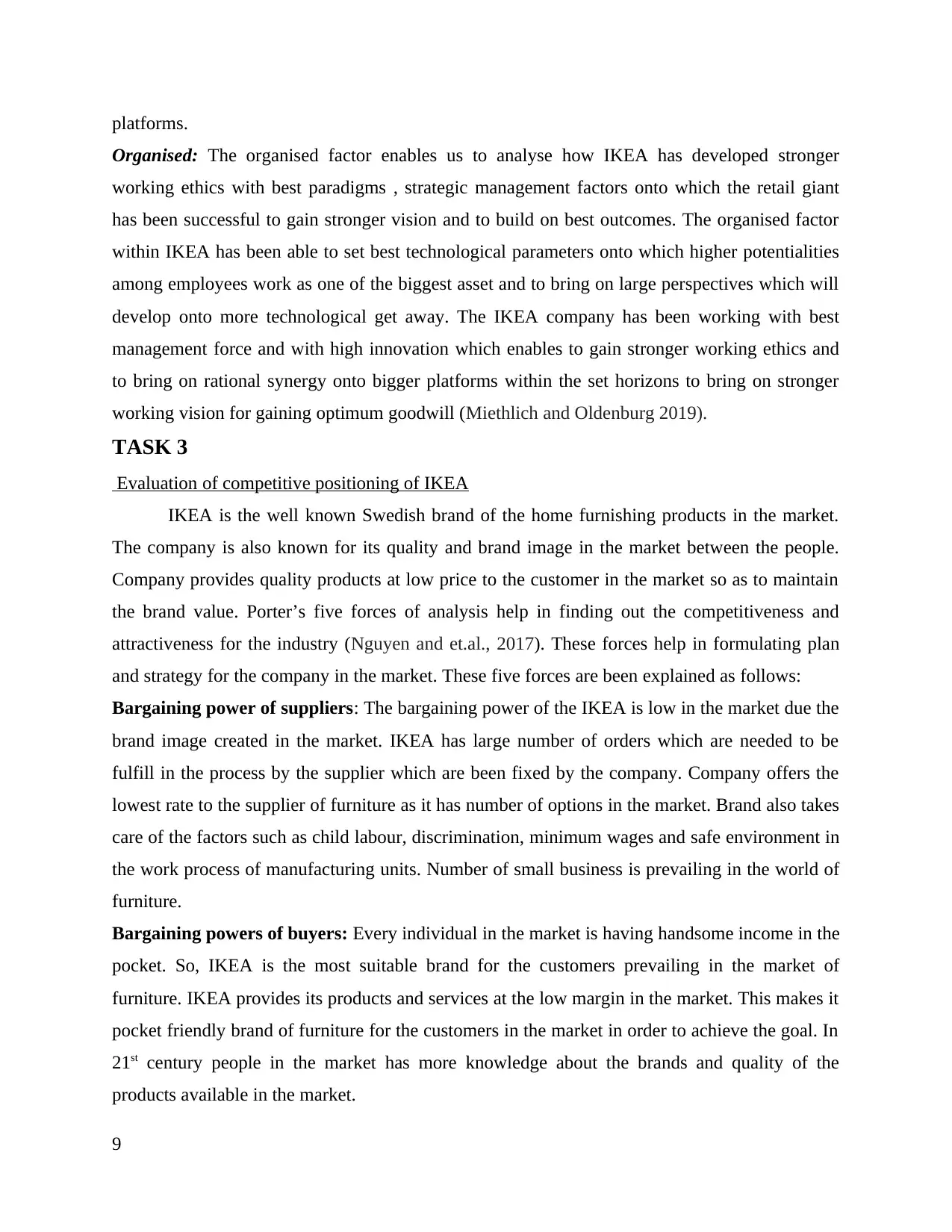
platforms.
Organised: The organised factor enables us to analyse how IKEA has developed stronger
working ethics with best paradigms , strategic management factors onto which the retail giant
has been successful to gain stronger vision and to build on best outcomes. The organised factor
within IKEA has been able to set best technological parameters onto which higher potentialities
among employees work as one of the biggest asset and to bring on large perspectives which will
develop onto more technological get away. The IKEA company has been working with best
management force and with high innovation which enables to gain stronger working ethics and
to bring on rational synergy onto bigger platforms within the set horizons to bring on stronger
working vision for gaining optimum goodwill (Miethlich and Oldenburg 2019).
TASK 3
Evaluation of competitive positioning of IKEA
IKEA is the well known Swedish brand of the home furnishing products in the market.
The company is also known for its quality and brand image in the market between the people.
Company provides quality products at low price to the customer in the market so as to maintain
the brand value. Porter’s five forces of analysis help in finding out the competitiveness and
attractiveness for the industry (Nguyen and et.al., 2017). These forces help in formulating plan
and strategy for the company in the market. These five forces are been explained as follows:
Bargaining power of suppliers: The bargaining power of the IKEA is low in the market due the
brand image created in the market. IKEA has large number of orders which are needed to be
fulfill in the process by the supplier which are been fixed by the company. Company offers the
lowest rate to the supplier of furniture as it has number of options in the market. Brand also takes
care of the factors such as child labour, discrimination, minimum wages and safe environment in
the work process of manufacturing units. Number of small business is prevailing in the world of
furniture.
Bargaining powers of buyers: Every individual in the market is having handsome income in the
pocket. So, IKEA is the most suitable brand for the customers prevailing in the market of
furniture. IKEA provides its products and services at the low margin in the market. This makes it
pocket friendly brand of furniture for the customers in the market in order to achieve the goal. In
21st century people in the market has more knowledge about the brands and quality of the
products available in the market.
9
Organised: The organised factor enables us to analyse how IKEA has developed stronger
working ethics with best paradigms , strategic management factors onto which the retail giant
has been successful to gain stronger vision and to build on best outcomes. The organised factor
within IKEA has been able to set best technological parameters onto which higher potentialities
among employees work as one of the biggest asset and to bring on large perspectives which will
develop onto more technological get away. The IKEA company has been working with best
management force and with high innovation which enables to gain stronger working ethics and
to bring on rational synergy onto bigger platforms within the set horizons to bring on stronger
working vision for gaining optimum goodwill (Miethlich and Oldenburg 2019).
TASK 3
Evaluation of competitive positioning of IKEA
IKEA is the well known Swedish brand of the home furnishing products in the market.
The company is also known for its quality and brand image in the market between the people.
Company provides quality products at low price to the customer in the market so as to maintain
the brand value. Porter’s five forces of analysis help in finding out the competitiveness and
attractiveness for the industry (Nguyen and et.al., 2017). These forces help in formulating plan
and strategy for the company in the market. These five forces are been explained as follows:
Bargaining power of suppliers: The bargaining power of the IKEA is low in the market due the
brand image created in the market. IKEA has large number of orders which are needed to be
fulfill in the process by the supplier which are been fixed by the company. Company offers the
lowest rate to the supplier of furniture as it has number of options in the market. Brand also takes
care of the factors such as child labour, discrimination, minimum wages and safe environment in
the work process of manufacturing units. Number of small business is prevailing in the world of
furniture.
Bargaining powers of buyers: Every individual in the market is having handsome income in the
pocket. So, IKEA is the most suitable brand for the customers prevailing in the market of
furniture. IKEA provides its products and services at the low margin in the market. This makes it
pocket friendly brand of furniture for the customers in the market in order to achieve the goal. In
21st century people in the market has more knowledge about the brands and quality of the
products available in the market.
9
⊘ This is a preview!⊘
Do you want full access?
Subscribe today to unlock all pages.

Trusted by 1+ million students worldwide
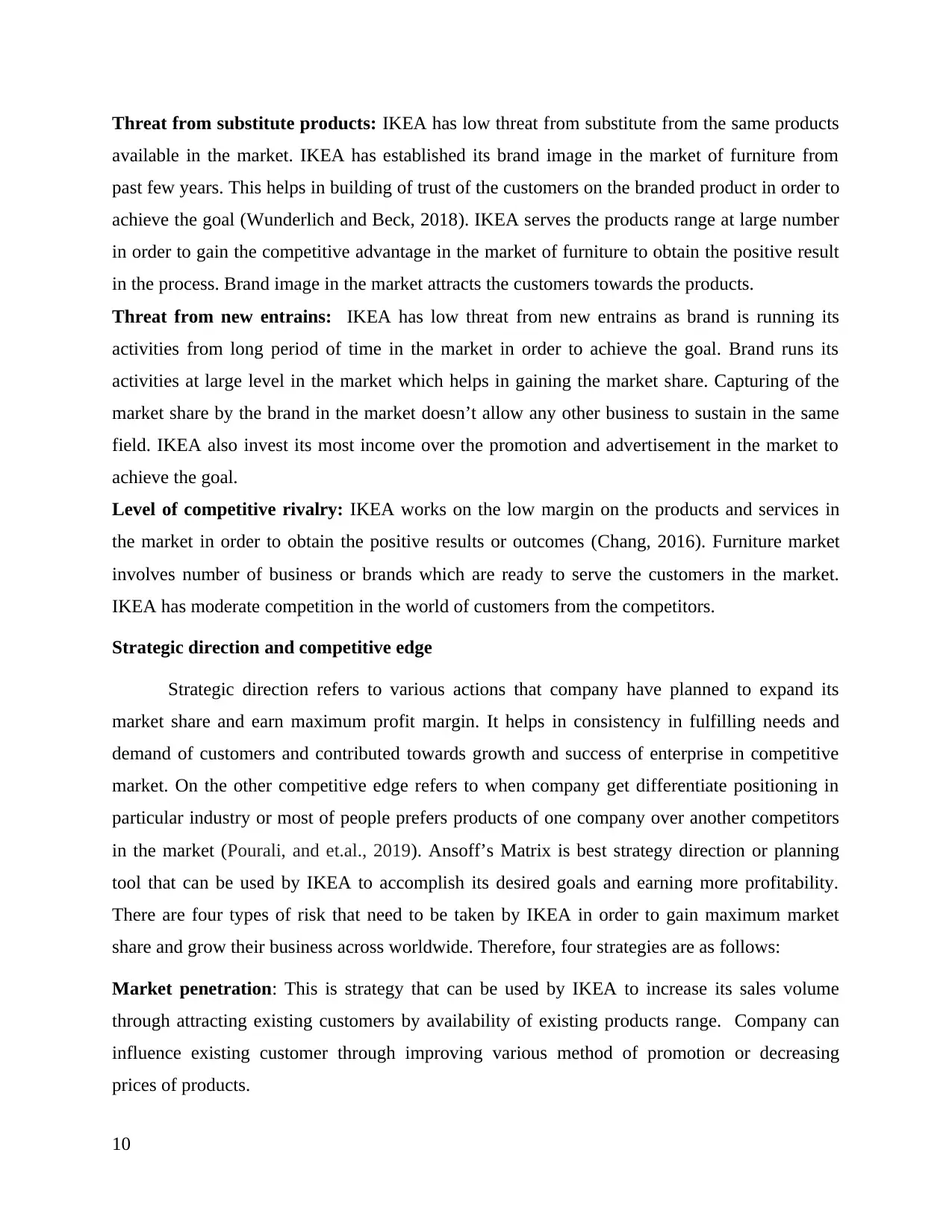
Threat from substitute products: IKEA has low threat from substitute from the same products
available in the market. IKEA has established its brand image in the market of furniture from
past few years. This helps in building of trust of the customers on the branded product in order to
achieve the goal (Wunderlich and Beck, 2018). IKEA serves the products range at large number
in order to gain the competitive advantage in the market of furniture to obtain the positive result
in the process. Brand image in the market attracts the customers towards the products.
Threat from new entrains: IKEA has low threat from new entrains as brand is running its
activities from long period of time in the market in order to achieve the goal. Brand runs its
activities at large level in the market which helps in gaining the market share. Capturing of the
market share by the brand in the market doesn’t allow any other business to sustain in the same
field. IKEA also invest its most income over the promotion and advertisement in the market to
achieve the goal.
Level of competitive rivalry: IKEA works on the low margin on the products and services in
the market in order to obtain the positive results or outcomes (Chang, 2016). Furniture market
involves number of business or brands which are ready to serve the customers in the market.
IKEA has moderate competition in the world of customers from the competitors.
Strategic direction and competitive edge
Strategic direction refers to various actions that company have planned to expand its
market share and earn maximum profit margin. It helps in consistency in fulfilling needs and
demand of customers and contributed towards growth and success of enterprise in competitive
market. On the other competitive edge refers to when company get differentiate positioning in
particular industry or most of people prefers products of one company over another competitors
in the market (Pourali, and et.al., 2019). Ansoff’s Matrix is best strategy direction or planning
tool that can be used by IKEA to accomplish its desired goals and earning more profitability.
There are four types of risk that need to be taken by IKEA in order to gain maximum market
share and grow their business across worldwide. Therefore, four strategies are as follows:
Market penetration: This is strategy that can be used by IKEA to increase its sales volume
through attracting existing customers by availability of existing products range. Company can
influence existing customer through improving various method of promotion or decreasing
prices of products.
10
available in the market. IKEA has established its brand image in the market of furniture from
past few years. This helps in building of trust of the customers on the branded product in order to
achieve the goal (Wunderlich and Beck, 2018). IKEA serves the products range at large number
in order to gain the competitive advantage in the market of furniture to obtain the positive result
in the process. Brand image in the market attracts the customers towards the products.
Threat from new entrains: IKEA has low threat from new entrains as brand is running its
activities from long period of time in the market in order to achieve the goal. Brand runs its
activities at large level in the market which helps in gaining the market share. Capturing of the
market share by the brand in the market doesn’t allow any other business to sustain in the same
field. IKEA also invest its most income over the promotion and advertisement in the market to
achieve the goal.
Level of competitive rivalry: IKEA works on the low margin on the products and services in
the market in order to obtain the positive results or outcomes (Chang, 2016). Furniture market
involves number of business or brands which are ready to serve the customers in the market.
IKEA has moderate competition in the world of customers from the competitors.
Strategic direction and competitive edge
Strategic direction refers to various actions that company have planned to expand its
market share and earn maximum profit margin. It helps in consistency in fulfilling needs and
demand of customers and contributed towards growth and success of enterprise in competitive
market. On the other competitive edge refers to when company get differentiate positioning in
particular industry or most of people prefers products of one company over another competitors
in the market (Pourali, and et.al., 2019). Ansoff’s Matrix is best strategy direction or planning
tool that can be used by IKEA to accomplish its desired goals and earning more profitability.
There are four types of risk that need to be taken by IKEA in order to gain maximum market
share and grow their business across worldwide. Therefore, four strategies are as follows:
Market penetration: This is strategy that can be used by IKEA to increase its sales volume
through attracting existing customers by availability of existing products range. Company can
influence existing customer through improving various method of promotion or decreasing
prices of products.
10
Paraphrase This Document
Need a fresh take? Get an instant paraphrase of this document with our AI Paraphraser
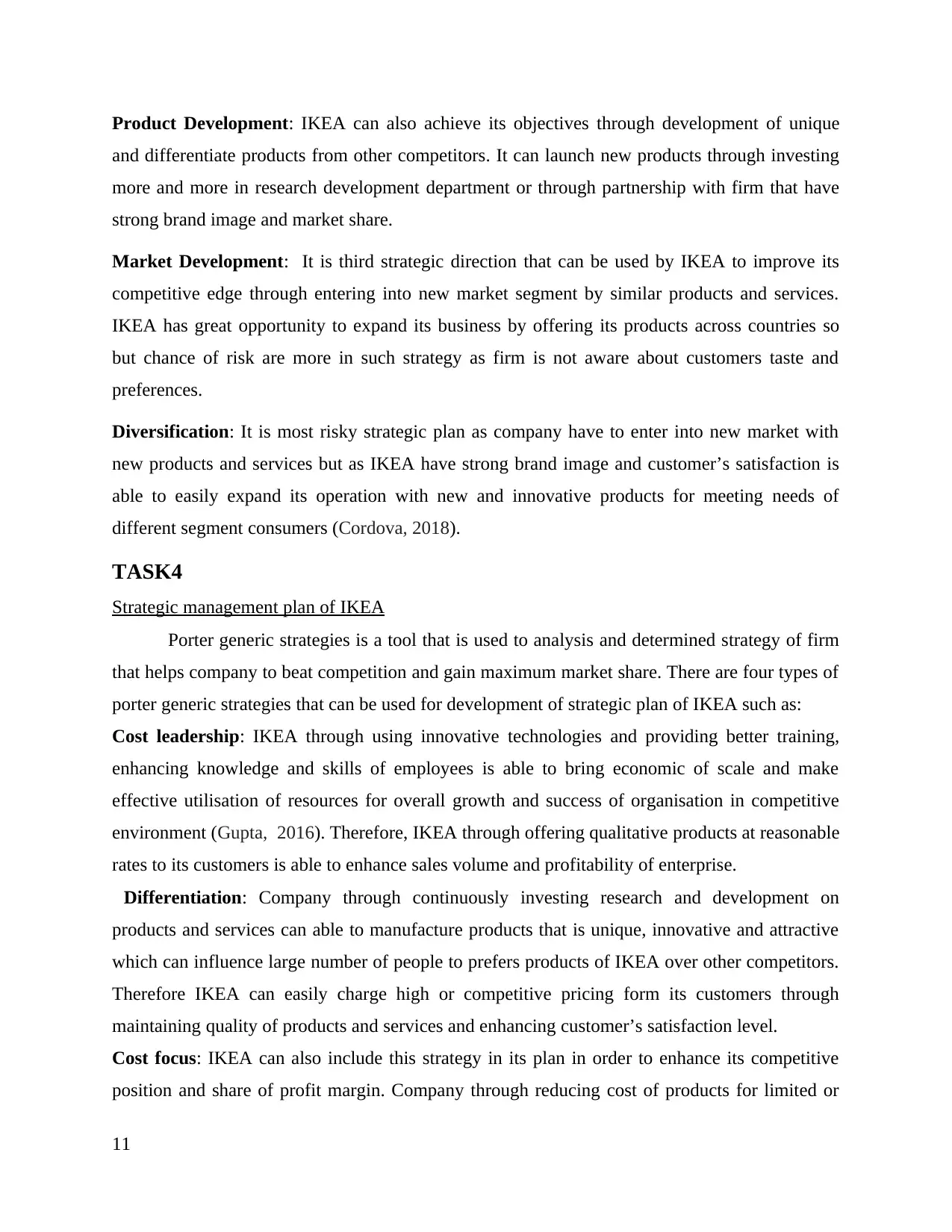
Product Development: IKEA can also achieve its objectives through development of unique
and differentiate products from other competitors. It can launch new products through investing
more and more in research development department or through partnership with firm that have
strong brand image and market share.
Market Development: It is third strategic direction that can be used by IKEA to improve its
competitive edge through entering into new market segment by similar products and services.
IKEA has great opportunity to expand its business by offering its products across countries so
but chance of risk are more in such strategy as firm is not aware about customers taste and
preferences.
Diversification: It is most risky strategic plan as company have to enter into new market with
new products and services but as IKEA have strong brand image and customer’s satisfaction is
able to easily expand its operation with new and innovative products for meeting needs of
different segment consumers (Cordova, 2018).
TASK4
Strategic management plan of IKEA
Porter generic strategies is a tool that is used to analysis and determined strategy of firm
that helps company to beat competition and gain maximum market share. There are four types of
porter generic strategies that can be used for development of strategic plan of IKEA such as:
Cost leadership: IKEA through using innovative technologies and providing better training,
enhancing knowledge and skills of employees is able to bring economic of scale and make
effective utilisation of resources for overall growth and success of organisation in competitive
environment (Gupta, 2016). Therefore, IKEA through offering qualitative products at reasonable
rates to its customers is able to enhance sales volume and profitability of enterprise.
Differentiation: Company through continuously investing research and development on
products and services can able to manufacture products that is unique, innovative and attractive
which can influence large number of people to prefers products of IKEA over other competitors.
Therefore IKEA can easily charge high or competitive pricing form its customers through
maintaining quality of products and services and enhancing customer’s satisfaction level.
Cost focus: IKEA can also include this strategy in its plan in order to enhance its competitive
position and share of profit margin. Company through reducing cost of products for limited or
11
and differentiate products from other competitors. It can launch new products through investing
more and more in research development department or through partnership with firm that have
strong brand image and market share.
Market Development: It is third strategic direction that can be used by IKEA to improve its
competitive edge through entering into new market segment by similar products and services.
IKEA has great opportunity to expand its business by offering its products across countries so
but chance of risk are more in such strategy as firm is not aware about customers taste and
preferences.
Diversification: It is most risky strategic plan as company have to enter into new market with
new products and services but as IKEA have strong brand image and customer’s satisfaction is
able to easily expand its operation with new and innovative products for meeting needs of
different segment consumers (Cordova, 2018).
TASK4
Strategic management plan of IKEA
Porter generic strategies is a tool that is used to analysis and determined strategy of firm
that helps company to beat competition and gain maximum market share. There are four types of
porter generic strategies that can be used for development of strategic plan of IKEA such as:
Cost leadership: IKEA through using innovative technologies and providing better training,
enhancing knowledge and skills of employees is able to bring economic of scale and make
effective utilisation of resources for overall growth and success of organisation in competitive
environment (Gupta, 2016). Therefore, IKEA through offering qualitative products at reasonable
rates to its customers is able to enhance sales volume and profitability of enterprise.
Differentiation: Company through continuously investing research and development on
products and services can able to manufacture products that is unique, innovative and attractive
which can influence large number of people to prefers products of IKEA over other competitors.
Therefore IKEA can easily charge high or competitive pricing form its customers through
maintaining quality of products and services and enhancing customer’s satisfaction level.
Cost focus: IKEA can also include this strategy in its plan in order to enhance its competitive
position and share of profit margin. Company through reducing cost of products for limited or
11
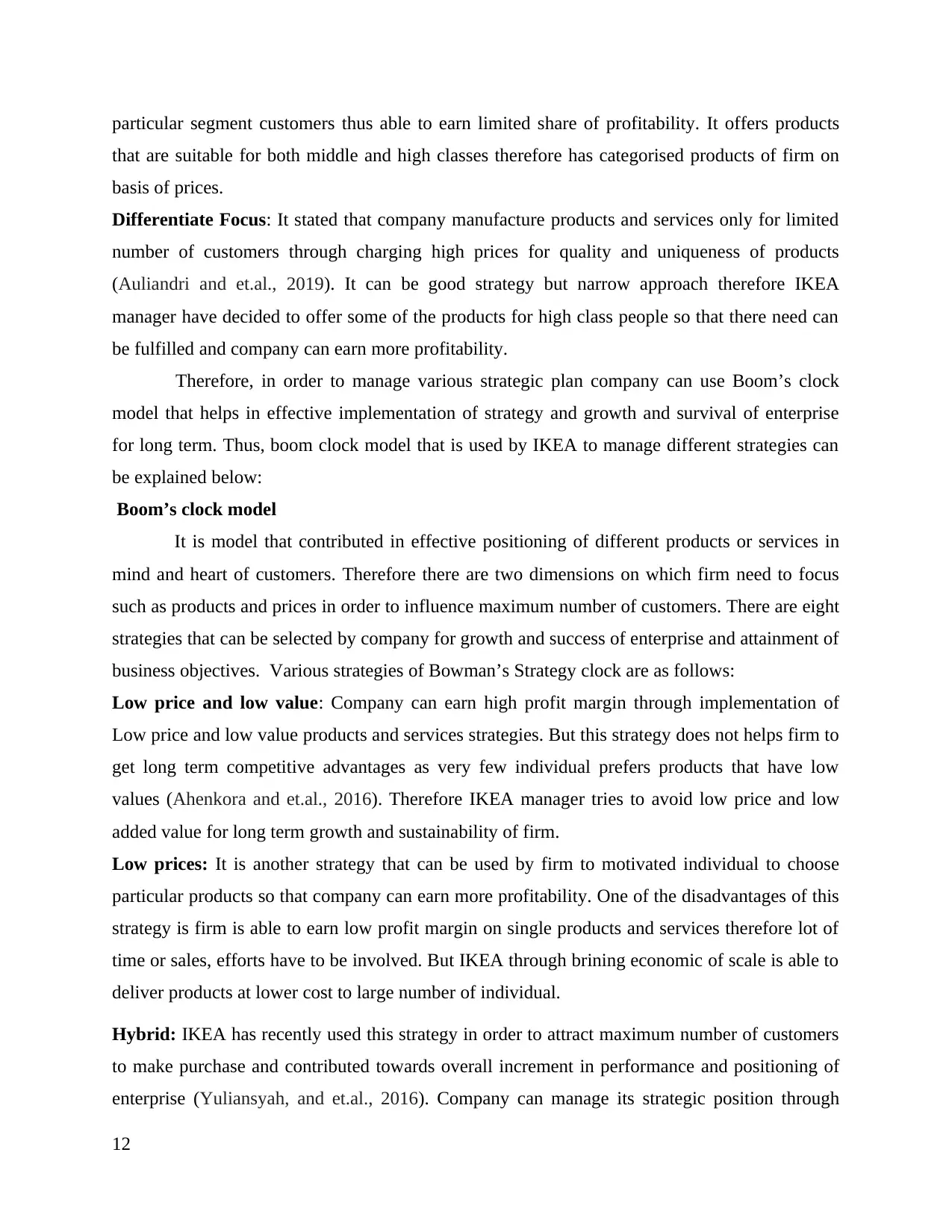
particular segment customers thus able to earn limited share of profitability. It offers products
that are suitable for both middle and high classes therefore has categorised products of firm on
basis of prices.
Differentiate Focus: It stated that company manufacture products and services only for limited
number of customers through charging high prices for quality and uniqueness of products
(Auliandri and et.al., 2019). It can be good strategy but narrow approach therefore IKEA
manager have decided to offer some of the products for high class people so that there need can
be fulfilled and company can earn more profitability.
Therefore, in order to manage various strategic plan company can use Boom’s clock
model that helps in effective implementation of strategy and growth and survival of enterprise
for long term. Thus, boom clock model that is used by IKEA to manage different strategies can
be explained below:
Boom’s clock model
It is model that contributed in effective positioning of different products or services in
mind and heart of customers. Therefore there are two dimensions on which firm need to focus
such as products and prices in order to influence maximum number of customers. There are eight
strategies that can be selected by company for growth and success of enterprise and attainment of
business objectives. Various strategies of Bowman’s Strategy clock are as follows:
Low price and low value: Company can earn high profit margin through implementation of
Low price and low value products and services strategies. But this strategy does not helps firm to
get long term competitive advantages as very few individual prefers products that have low
values (Ahenkora and et.al., 2016). Therefore IKEA manager tries to avoid low price and low
added value for long term growth and sustainability of firm.
Low prices: It is another strategy that can be used by firm to motivated individual to choose
particular products so that company can earn more profitability. One of the disadvantages of this
strategy is firm is able to earn low profit margin on single products and services therefore lot of
time or sales, efforts have to be involved. But IKEA through brining economic of scale is able to
deliver products at lower cost to large number of individual.
Hybrid: IKEA has recently used this strategy in order to attract maximum number of customers
to make purchase and contributed towards overall increment in performance and positioning of
enterprise (Yuliansyah, and et.al., 2016). Company can manage its strategic position through
12
that are suitable for both middle and high classes therefore has categorised products of firm on
basis of prices.
Differentiate Focus: It stated that company manufacture products and services only for limited
number of customers through charging high prices for quality and uniqueness of products
(Auliandri and et.al., 2019). It can be good strategy but narrow approach therefore IKEA
manager have decided to offer some of the products for high class people so that there need can
be fulfilled and company can earn more profitability.
Therefore, in order to manage various strategic plan company can use Boom’s clock
model that helps in effective implementation of strategy and growth and survival of enterprise
for long term. Thus, boom clock model that is used by IKEA to manage different strategies can
be explained below:
Boom’s clock model
It is model that contributed in effective positioning of different products or services in
mind and heart of customers. Therefore there are two dimensions on which firm need to focus
such as products and prices in order to influence maximum number of customers. There are eight
strategies that can be selected by company for growth and success of enterprise and attainment of
business objectives. Various strategies of Bowman’s Strategy clock are as follows:
Low price and low value: Company can earn high profit margin through implementation of
Low price and low value products and services strategies. But this strategy does not helps firm to
get long term competitive advantages as very few individual prefers products that have low
values (Ahenkora and et.al., 2016). Therefore IKEA manager tries to avoid low price and low
added value for long term growth and sustainability of firm.
Low prices: It is another strategy that can be used by firm to motivated individual to choose
particular products so that company can earn more profitability. One of the disadvantages of this
strategy is firm is able to earn low profit margin on single products and services therefore lot of
time or sales, efforts have to be involved. But IKEA through brining economic of scale is able to
deliver products at lower cost to large number of individual.
Hybrid: IKEA has recently used this strategy in order to attract maximum number of customers
to make purchase and contributed towards overall increment in performance and positioning of
enterprise (Yuliansyah, and et.al., 2016). Company can manage its strategic position through
12
⊘ This is a preview!⊘
Do you want full access?
Subscribe today to unlock all pages.

Trusted by 1+ million students worldwide
1 out of 16
Related Documents
Your All-in-One AI-Powered Toolkit for Academic Success.
+13062052269
info@desklib.com
Available 24*7 on WhatsApp / Email
![[object Object]](/_next/static/media/star-bottom.7253800d.svg)
Unlock your academic potential
Copyright © 2020–2025 A2Z Services. All Rights Reserved. Developed and managed by ZUCOL.





